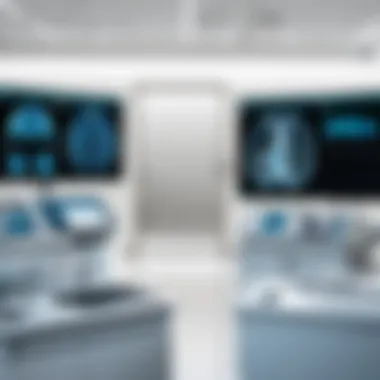Unleashing the Power of PACS Systems in Modern Healthcare Facilities


Industry Overview
Picture Archiving and Communication System (PACS) plays a pivotal role in modern hospitals, transforming medical imaging management and elevating patient care standards. The adoption of PACS has streamlined healthcare workflows, leading to more efficient and effective diagnostic procedures. Understanding the significance and functionality of PACS systems is crucial for healthcare professionals and decision-makers looking to enhance their facility's imaging capabilities.
Top Software Options
When considering PACS solutions for hospital settings, it is essential to review leading software providers in the industry. Conducting a feature comparison of top software solutions allows hospitals to identify the most suitable option for their specific needs. Moreover, evaluating the pricing structures of different software options helps in making informed decisions based on budgetary constraints and desired functionalities.
Selection Criteria
Choosing the right PACS software involves analyzing important factors that align with the hospital's imaging requirements. By understanding common mistakes to avoid during the selection process, decision-makers can mitigate risks and ensure a successful implementation. Determining the right fit for business needs requires a thorough assessment of functionalities, scalability, and compatibility with existing systems.
Implementation Strategies
To ensure a smooth implementation of PACS software, hospitals should follow best practices recommended by industry experts. Integrating the new software with existing systems and processes is vital for seamless workflow transitions and data management. Accessing training and support resources facilitates the successful deployment of PACS solutions, empowering hospital staff to leverage the full capabilities of the system.
Future Trends
The future of PACS systems in hospital settings promises continued innovation and technological advancements. Predictions for the industry-specific software landscape forecast the integration of upcoming technologies that will further enhance medical imaging management. Recommendations for future-proofing technology stacks highlight the importance of adapting to evolving industry trends and embracing cutting-edge solutions for sustainable growth.
Introduction to PACS Systems
The realm of modern hospitals is undergoing a profound transformation, resonating with the integration of Picture Archiving and Communication System (PACS) facilities. In this digital age, the crucial role of PACS in revolutionizing medical imaging management, enhancing patient care, and streamlining healthcare workflows cannot be overstated. PACS serves as the backbone of contemporary medical practices, facilitating the seamless storage, retrieval, and transmission of crucial diagnostic imagery within healthcare institutions. Its impact reverberates across the entire healthcare spectrum, optimizing operational efficiency and enhancing clinical outcomes.
Definition and Purpose of a PACS System
Understanding the acronym PACS
Picture Archiving and Communication System abbreviated as PACS delineates a pivotal aspect of digital healthcare frameworks. It embodies a sophisticated infrastructure designed to centralize radiological images, eliminating the constraints of physical film-based storage. The hallmark of PACS lies in its versatility and efficiency, offering healthcare providers instantaneous access to a vast repository of patient images. This expeditious retrieval capability significantly enhances diagnostic processes, enabling practitioners to make informed clinical decisions promptly. The streamlined workflows afforded by PACS ensure timely interventions and comprehensive patient care, fostering a paradigm shift in healthcare delivery mechanisms.
Overview of the primary objectives of PACS
The primary objectives underscored by PACS encapsulate a multifaceted approach towards enhancing medical imaging operations. PACS principally aims to facilitate the rapid acquisition, storage, and distribution of radiological imagery within healthcare settings. By consolidating disparate imaging modalities onto a unified platform, PACS mitigates the challenges posed by physical archives, enabling clinicians to access patient data systematically. Moreover, PACS promotes interoperability among various healthcare systems, fostering collaborative care practices and ensuring seamless information transfer. This convergence of imaging resources under the aegis of PACS engenders a cooperative ecosystem that fosters diagnostic precision, treatment efficacy, and patient safety.


Evolution of PACS in Healthcare
Historical background of PACS implementation
The historical progression of PACS implementation traces its origins to the burgeoning need for advanced imaging solutions in the healthcare milieu. Over the decades, PACS has metamorphosed from rudimentary image storage systems to intricate digital repositories infused with cutting-edge technologies. The evolution of PACS epitomizes the healthcare sector's relentless pursuit of innovation and efficiency, revolutionizing conventional radiological practices. By transitioning from traditional film-based workflows to digital modalities, PACS has enhanced the diagnostic capacities of healthcare providers, engendering a seismic shift in patient care paradigms.
Impact of digitalization on medical imaging practices
The advent of digitalization has redefined the landscape of medical imaging practices, precipitating a tectonic shift towards streamlined, technology-driven healthcare frameworks. The impact of digitalization on medical imaging practices is emblematic of a monumental paradigm shift towards precision, agility, and interoperability in diagnostic processes. By harnessing digital technologies, healthcare institutions can transcend temporal and spatial barriers, promoting ubiquitous access to diagnostic imagery and fostering collaborative care models. The integration of digital platforms within medical imaging practices augurs well for enhanced clinical decision-making, accelerated diagnostic workflows, and elevated patient care standards.
Key Components of a PACS System
In delving into the intricate workings of PACS systems within modern healthcare facilities, one must grasp the pivotal role played by the key components of such systems. Image acquisition and storage serve as pillars on which the entire PACS infrastructure stands. DICOM standards, short for Digital Imaging and Communications in Medicine, dictate the protocols for image capture, ensuring compatibility and uniformity across various imaging devices. Embracing cloud-based storage solutions for medical images brings about scalability, accessibility, and cost-efficiency to the storage aspect of PACS systems. Despite facing challenges like cybersecurity threats, the benefits of adopting cloud technology for image storage outweigh the risks.
Image Acquisition and Storage
DICOM standards in image capture
Digital Imaging and Communications in Medicine (DICOM) standards play a vital role in refining image capture practices within the healthcare landscape. These standards provide a common language for medical imaging devices to communicate effectively, promoting interoperability and seamless integration of diverse imaging modalities. The robustness of DICOM standards in ensuring consistent image quality, metadata inclusion, and structured reporting elevates the efficiency and accuracy of diagnostic procedures. However, compliance with DICOM standards necessitates dedicated resources for maintenance and updates, posing a challenge for some healthcare facilities.
Cloud-based storage solutions for medical images
The advent of cloud-based storage solutions revolutionizes how medical images are archived and accessed within PACS systems. By leveraging cloud infrastructure, healthcare providers can overcome inherent limitations of traditional on-premises storage, such as physical space constraints and heightened maintenance requirements. Additionally, cloud storage facilitates real-time image retrieval, enabling swift access to critical medical data for timely decision-making. Despite concerns surrounding data security and privacy in the cloud, robust encryption protocols and access controls offer a layer of protection against unauthorized access and data breaches.
Data Transmission and Distribution
Keyword Analysis
Efficient methods for transmitting images within a healthcare facility
Facilitating the seamless transfer of medical images within a healthcare facility is critical for expedient diagnostics and treatment planning. Efficient transmission methods optimize image sharing between departments, enhancing multidisciplinary collaboration and patient care coordination. Whether through high-speed networks or workflow automation tools, efficient data transmission reduces latency, enabling quick access to imaging studies across different hospital units. However, technical glitches or network congestion may impede the smooth flow of image data, necessitating robust troubleshooting mechanisms to maintain operational continuity.
Secure sharing of images across different healthcare networks


Ensuring the secure exchange of medical images across diverse healthcare networks is essential to safeguard patient privacy and prevent unauthorized data breaches. Secure sharing mechanisms, such as encrypted networks and user authentication protocols, fortify the integrity and confidentiality of transmitted images. By restricting access to authorized personnel and implementing audit trails, healthcare institutions can uphold regulatory compliance and mitigate the risks associated with data interception or manipulation. Nonetheless, the complexity of maintaining secure image sharing channels requires ongoing vigilance and adherence to established cybersecurity best practices.
Benefits of Implementing a PACS System
In the realm of modern hospitals, the integration of PACS systems stands as a pivotal advancement. Implementing a PACS system brings forth a paradigm shift in medical imaging management and healthcare workflows. The consolidation of image storage, retrieval, and transmission under the PACS umbrella streamlines processes, enhancing operational efficiency and diagnostic accuracy. By centralizing imaging data, healthcare providers can expedite access to critical information, reducing delays in patient care. Moreover, the transition to PACS enables seamless collaboration among healthcare professionals, fostering a multidisciplinary approach to patient treatment.
Enhanced Workflow Efficiency
Streamlining radiology processes through PACS
Within the domain of PACS systems, the aspect of streamlining radiology processes plays a crucial role in refining operational efficiency. By utilizing PACS technology, radiology departments can automate tasks such as image capture, archiving, and retrieval, reducing manual intervention and enhancing productivity. The key characteristic of streamlining radiology processes through PACS lies in its ability to unify imaging workflows, eliminating redundant steps and minimizing the risk of errors. This automated approach not only accelerates the pace of image management but also ensures data integrity and consistency across the healthcare ecosystem.
Reducing turnaround times for image interpretations
Another significant facet of PACS implementation is the reduction of turnaround times for image interpretations. By leveraging PACS features like advanced image processing algorithms and remote access capabilities, healthcare providers can expedite the interpretation and reporting of medical images. The pivotal characteristic of this feature is its capacity to expedite the delivery of diagnostic insights, enabling prompt decision-making in patient care. While this approach enhances operational efficiency and patient satisfaction, it also poses challenges related to data security and information accuracy.
Improved Patient Care and Outcomes
Enhancing diagnostic accuracy with advanced imaging tools
Enhancing diagnostic accuracy through the integration of advanced imaging tools underscores the transformative impact of PACS systems on patient care. By leveraging AI-driven algorithms and image enhancement technologies, healthcare professionals can extract detailed insights from medical images, leading to precise diagnoses and personalized treatment plans. The distinctive feature of enhancing diagnostic accuracy with advanced imaging tools lies in its capacity to unveil subtle abnormalities and pathological indicators that might evade traditional analysis. While this technological advancement empowers clinical decision-making, it also necessitates continuous validation and monitoring to ensure diagnostic reliability.
Facilitating interdisciplinary collaboration for comprehensive patient treatment
Furthermore, PACS systems facilitate interdisciplinary collaboration, reshaping the landscape of patient-centric care. By enabling seamless sharing of imaging data across various healthcare disciplines, PACS fosters holistic approaches to patient treatment, integrating diverse perspectives and expertise. The hallmark feature of facilitating interdisciplinary collaboration with PACS is its ability to synchronize care plans, ensuring comprehensive and cohesive interventions for patients. This collaborative framework not only optimizes treatment outcomes but also engenders a culture of knowledge exchange and continuous learning within the healthcare community.
Challenges and Considerations in PACS Implementation
Challenges and Considerations in the Implementation of Picture Archiving and Communication System (PACS) play a vital role in the successful integration of this technology within modern healthcare facilities. As hospitals transition towards digitalization, ensuring seamless incorporation of PACS into existing systems becomes paramount. The complexities of merging PACS with Electronic Health Records (EHR) and other medical software demand thorough planning and execution. Addressing these challenges effectively not only streamlines operational workflows but also enhances the quality of patient care by facilitating quick access and sharing of medical images across departments.
Integration with Existing Hospital Systems
Ensuring Interoperability with Electronic Health Records (EHR)


In the realm of PACS implementation, the ability to ensure interoperability with Electronic Health Records (EHR) stands out as a critical consideration. Seamless integration between PACS and EHR systems enables healthcare providers to access comprehensive patient data alongside associated medical images swiftly. This synergy not only optimizes diagnostic processes but also enhances the continuum of care delivery, promoting efficient decision-making based on synchronized patient information. The interoperability feature of PACS with EHR aligns with the overarching goal of enhancing operational efficiency and clinical outcomes within the medical landscape.
Addressing Compatibility Issues with Other Medical Software
Another key aspect in PACS implementation pertains to effectively addressing compatibility issues with various medical software utilized within hospital settings. Ensuring that PACS can seamlessly interact with different proprietary systems and specialized medical applications is essential. The ability to navigate through diverse software interfaces without compromising data integrity or system performance is instrumental in maximizing the benefits of PACS deployment. By mitigating compatibility challenges, healthcare facilities can harness the full potential of their technological infrastructure, harnessing the advantages presented by a cohesive and integrated digital ecosystem.
Data Security and Patient Privacy
Implementing Robust Cybersecurity Measures for Image Protection
Safeguarding patient data and medical images against cyber threats is a crucial component of PACS implementation. Implementing robust cybersecurity measures ensures that sensitive imaging data remains protected from unauthorized access, tampering, or exploitation. By fortifying the security protocols surrounding image storage and transmission, healthcare providers can uphold patient confidentiality and maintain the integrity of diagnostic information, thereby cultivating trust and compliance with regulatory standards.
Compliance with HIPAA Regulations for Safeguarding Patient Information
Compliance with the Health Insurance Portability and Accountability Act (HIPAA) regulations stands as a cornerstone in upholding patient privacy and data security within PACS systems. Adhering to HIPAA guidelines mandates rigorous protocols for handling, storing, and sharing medical images, necessitating stringent measures to prevent breaches and unauthorized disclosures. By aligning PACS operations with HIPAA requirements, healthcare organizations bolster their commitment to patient privacy and regulatory compliance, establishing a foundation of trust with both patients and regulatory bodies.
Future Trends and Innovations in PACS Technology
In the realm of modern hospitals, the landscape of Picture Archiving and Communication System (PACS) technology is constantly evolving, paving the way for futuristic trends and innovations. As the heartbeat of medical imaging management, the integration of Artificial Intelligence (AI) stands at the forefront of this technological revolution. One pivotal element reshaping the trajectory of PACS technology is leveraging AI for image analysis, a paradigm shift in diagnostic methodologies. The fusion of AI algorithms with PACS systems facilitates automated diagnosis and image recognition, expediting the interpretation process and enhancing efficiency within healthcare settings. The seamless synergy between AI capabilities and PACS functionality streamlines radiology practices, underscoring the significance of this amalgamation for the future of medical imaging.
AI Integration for Image Analysis
Utilizing artificial intelligence for automated diagnosis and image recognition
The utilization of artificial intelligence for automated diagnosis and image recognition is a game-changer in the medical realm. By harnessing the power of AI algorithms, healthcare providers can achieve unparalleled accuracy and swiftness in diagnosing medical conditions through image analysis. This sophisticated technology not only expedites the diagnostic process but also reduces the margin of error, ultimately improving patient outcomes. With its ability to recognize patterns and anomalies in medical images, AI integration in PACS systems revolutionizes the standard of care, setting a new precedent in medical imaging management.
Enhancing predictive analytics for personalized patient care
Another groundbreaking facet of AI integration in PACS technology is its capacity to enhance predictive analytics for personalized patient care. By analyzing vast datasets and patient information, AI algorithms embedded within PACS systems generate tailored insights and prognoses, catering to individual patient needs. This personalized approach revolutionizes patient care by forecasting potential health complications, thus enabling proactive intervention and personalized treatment strategies. Moreover, the integration of predictive analytics amplifies the precision of diagnoses and treatment plans, contributing significantly to improved patient outcomes and healthcare efficacy.
Telemedicine and Remote Access
In parallel to AI integration, the advent of telemedicine and remote access capabilities within PACS systems ushers in a new era of healthcare accessibility and outreach. Facilitating virtual consultations and remote image viewing redefines the boundaries of traditional healthcare delivery by enabling seamless communication between healthcare providers and patients across geographical divides. This feature not only enhances patient convenience but also fosters rapid decision-making and interdisciplinary collaboration, thereby elevating the standard of care. The unique feature of remote access empowers healthcare professionals to extend their expertise to underserved populations, bridging the gap in healthcare disparities and ensuring equitable access to medical services.
Facilitating virtual consultations and remote image viewing
The facilitation of virtual consultations and remote image viewing through PACS systems transcends conventional healthcare paradigms, offering a dynamic platform for real-time interactions and expansive medical support. By leveraging telecommunication technologies, healthcare practitioners can engage with patients remotely, offering expert medical advice and guidance while remotely accessing diagnostic images for accurate assessments. This innovative approach not only enhances patient engagement and satisfaction but also optimizes healthcare resources, leading to a more efficient and patient-centric healthcare delivery model.
Expanding healthcare reach to underserved populations through telemedicine
Expanding healthcare reach to underserved populations through telemedicine signifies a pivotal shift in healthcare accessibility and inclusivity. By leveraging telemedicine capabilities integrated into PACS systems, healthcare providers can transcend traditional barriers and extend their services to marginalized communities and remote areas. This strategic approach not only empowers individuals to receive timely and quality healthcare services but also promotes preventive care and early intervention, ultimately enhancing health outcomes and promoting healthcare equity. The unique feature of telemedicine's reach to underserved populations redefines the scope of healthcare delivery, advocating for comprehensive and inclusive healthcare solutions to address the diverse needs of global populations.



